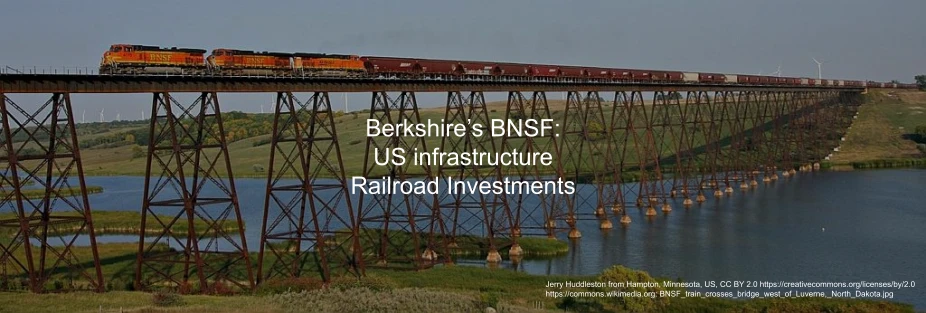Tags: BNSF
This fanpage is not officially affiliated with Berkshire Hathaway: Disclaimer

In this article, we analyze BNSF's financial performance from 2019 to 2022 and its capital allocation strategies, revealing how the company's investments in maintenance, expansion, and technology drive long-term growth and add value to Berkshire Hathaway's diverse portfolio.
The article is based on Berkshire Hathaway's 2022 annual report and BNSF's annual reports for the years 2019 to 2022.
1. Introduction
Berkshire Hathaway is a multinational conglomerate holding company that owns and manages a diverse range of businesses. Over the years, Berkshire has grown through strategic acquisitions and efficient capital allocation among its subsidiaries. One of the most significant subsidiaries within Berkshire's portfolio is the BNSF Railway Company (BNSF). As a Class I freight railroad, BNSF plays a crucial role in supporting Berkshire's overall financial performance.
The importance of efficient capital allocation within Berkshire Hathaway cannot be overstated. Capital allocation decisions can make or break a company's financial performance and, ultimately, shareholder value. As the Oracle of Omaha, Warren Buffett himself once said, "The heads of many companies are not skilled in capital allocation, and ... it is not surprising because most bosses rise to the top because they have excelled in an area such as marketing, production, engineering, administration or, sometimes, institutional politics."
In this article, we will delve into BNSF's financial performance from 2019 to 2022, analyze the company's capital allocation strategies, and explore the impact of these strategies on BNSF's performance and its contribution to Berkshire Hathaway's overall success.
2. BNSF's Financial Performance (2019-2022)
In this section, we will examine BNSF's key financial metrics from 2019 to 2022, compare the company's financial performance in each year, and analyze the trends in revenue and expenses.
a. Key financial metrics across the years
- 2019: Operating revenue of $23.5 billion, operating income of $8.1 billion, and operating ratio of 64.5%.
- 2020: Operating revenue of $20.9 billion, operating income of $7.7 billion, and operating ratio of 61.6%.
- 2021: Operating revenue of $23.3 billion, operating income of $8.8 billion, and operating ratio of 60.9%.
- 2022: Operating revenue of $25.9 billion, operating income of $8.6 billion, and operating ratio of 65.9%.
With these revised numbers, the updated analysis of BNSF's financial performance is as follows:
b. Comparison of financial performance in each year
The data shows that BNSF's financial performance has been relatively stable over the past four years, with modest fluctuations in revenue, income, and operating ratios. Despite the challenges posed by the COVID-19 pandemic in 2020, BNSF managed to maintain its financial performance and quickly rebounded in 2021, thanks to its efficient capital allocation and cost management strategies.
c. Analysis of revenue and expense trends
BNSF's revenue growth can be attributed to various factors, including increased demand for freight transportation, expansion of its railway network, and investments in technology that have improved the company's operational efficiency. On the other hand, BNSF has also managed to keep its expenses in check, primarily through investments in infrastructure that have reduced maintenance costs and increased the overall efficiency of the railroad system.
In the following sections, we will explore BNSF's capital allocation strategies and their impact on the company's performance in more detail.
3. Capital Allocation Strategies
BNSF has consistently focused on effective capital allocation to maintain its competitive edge and ensure a safe, efficient, and reliable railroad network. The company's primary capital allocation strategies have centered around investing in infrastructure, expansion, and technology improvements.
a. Infrastructure Investment: Maintenance and Replacement
BNSF has placed significant emphasis on maintaining and replacing its core network and related assets. The company allocated $2.55 billion in 2021 and $2.85 billion in 2023 for maintenance and replacement activities. These investments primarily go towards upgrading rail, track infrastructure like ballast and rail ties, and maintaining rolling stock. In 2023, BNSF's plan includes nearly 14,000 miles of track surfacing and/or undercutting work, and the replacement of 346 miles of rail and approximately 2.8 million rail ties. By maintaining a well-functioning and safe network, BNSF can effectively manage costs and ensure efficient operations.
b. Expansion and Efficiency Projects
To support the growth of its customer base, BNSF has allocated substantial resources to expansion and efficiency projects. In 2021, the company committed $1.2 billion to such projects, with an increased allocation of $709 million in 2023. Key projects in 2023 include the construction of a second bridge over the Missouri River, adding new track segments in Eastern Kansas and Southern California, a multi-year terminal and fueling project near Belen, New Mexico, and various intermodal facility expansion projects.
These expansion efforts not only increase BNSF's capacity to accommodate growing demand but also improve operational efficiency, allowing the company to better serve its Intermodal, Automotive, Agricultural, and Industrial Products customers.
c. Technological Advancements
BNSF has consistently invested in technology to enhance its operations, improve safety, and optimize resource allocation. The company has adopted advanced technologies like Positive Train Control (PTC), which improves safety by preventing train-to-train collisions and overspeed derailments. Moreover, BNSF has invested in data analytics and predictive maintenance tools that help the company monitor the condition of its assets and plan maintenance activities more effectively. These investments in technology have contributed to the company's ability to manage costs and maintain a competitive advantage in the industry.
d. Equipment Acquisitions
To ensure the smooth functioning of its operations, BNSF has allocated funds for acquiring new equipment. In 2023, the company has committed approximately $402 million for equipment acquisitions, which will help maintain its fleet and meet the growing demand for its services.
By allocating capital effectively across infrastructure maintenance, network expansion, technology improvements, and equipment acquisitions, BNSF has maintained a robust financial performance and continued growth in the face of changing market conditions and challenges.
3. Capital Allocation Strategies
BNSF has consistently focused on effective capital allocation to maintain its competitive edge and ensure a safe, efficient, and reliable railroad network. The company's primary capital allocation strategies have centered around investing in infrastructure, expansion, and technology improvements.
a. Infrastructure Investment: Maintenance and Replacement
BNSF has placed significant emphasis on maintaining and replacing its core network and related assets. In 2020, BNSF committed $2.41 billion to this component, with an increased allocation of $2.71 billion in 2021 and $2.85 billion in 2023. These investments primarily go towards upgrading rail, track infrastructure like ballast and rail ties, and maintaining rolling stock. In 2023, BNSF's plan includes nearly 14,000 miles of track surfacing and/or undercutting work, and the replacement of 346 miles of rail and approximately 2.8 million rail ties. By maintaining a well-functioning and safe network, BNSF can effectively manage costs and ensure efficient operations.
b. Expansion and Efficiency Projects
To support the growth of its customer base, BNSF has allocated substantial resources to expansion and efficiency projects. In 2020, the company committed $400 million to such projects, with an increased allocation of $580 million in 2021 and $709 million in 2023. Key projects in 2023 include the construction of a second bridge over the Missouri River, adding new track segments in Eastern Kansas and Southern California, a multi-year terminal and fueling project near Belen, New Mexico, and various intermodal facility expansion projects.
These expansion efforts not only increase BNSF's capacity to accommodate growing demand but also improve operational efficiency, allowing the company to better serve its Intermodal, Automotive, Agricultural, and Industrial Products customers.
c. Technological Advancements
BNSF has consistently invested in technology to enhance its operations, improve safety, and optimize resource allocation. The company has adopted advanced technologies like Positive Train Control (PTC), which improves safety by preventing train-to-train collisions and overspeed derailments. Moreover, BNSF has invested in data analytics and predictive maintenance tools that help the company monitor the condition of its assets and plan maintenance activities more effectively. These investments in technology have contributed to the company's ability to manage costs and maintain a competitive advantage in the industry.
d. Equipment Acquisitions
To ensure the smooth functioning of its operations, BNSF has allocated funds for acquiring new equipment. In 2020, the company committed approximately $180 million for equipment acquisitions, with an increased commitment of $259 million in 2021 and $402 million in 2023. These investments help maintain its fleet and meet the growing demand for its services.
By allocating capital effectively across infrastructure maintenance, network expansion, technology improvements, and equipment acquisitions, BNSF has maintained a robust financial performance and continued growth in the face of changing market conditions and challenges.
4. Financial Performance Overview
BNSF has demonstrated a strong financial performance over the years, with continuous growth in total revenues, alongside effective cost management. The company has experienced fluctuations in operating ratios, but it has consistently maintained profitability and a competitive position in the industry.
a. Total Revenues
Between 2019 and 2022, BNSF's total revenues saw an upward trajectory. In 2019, BNSF reported total revenues of $23.5 billion, which declined to $20.9 billion in 2020 due to the impact of the global pandemic. However, the company bounced back in 2021 with total revenues of $23.3 billion and further increased to $25.9 billion in 2022. This growth can be attributed to BNSF's strategic investments in infrastructure, expansion projects, and effective cost management.
b. Operating Expenses
BNSF has managed its operating expenses effectively, contributing to the company's overall financial performance. In 2019, operating expenses were $15.4 billion, which decreased to $13.1 billion in 2020, primarily due to reduced operations during the pandemic. However, as business rebounded, operating expenses increased to $14.5 billion in 2021 and further to $17.3 billion in 2022.
c. Operating Income
Despite fluctuations in revenues and expenses, BNSF has consistently maintained a healthy operating income. In 2019, operating income was $8.1 billion, followed by $7.7 billion in 2020, $8.8 billion in 2021, and $8.6 billion in 2022. This consistent operating income demonstrates the company's ability to adapt to changing market conditions and maintain profitability.
d. Net Income
BNSF's net income has also remained relatively stable throughout the period. In 2019, the company reported a net income of $5.5 billion, which declined to $5.2 billion in 2020 due to the pandemic's impact. However, net income increased marginally to $6.0 billion in 2021 before slightly declining to $5.9 billion in 2022.
e. Operating Ratios
The operating ratio is a key performance indicator in the railroad industry, reflecting the proportion of operating expenses to operating revenues. Lower operating ratios indicate greater efficiency and profitability. BNSF's operating ratio has experienced some fluctuations over the years. In 2019, the operating ratio was 64.5%, which improved to 61.6% in 2020. However, in 2021, the operating ratio increased to 60.9% before rising further to 65.9% in 2022.
Overall, BNSF's financial performance highlights the company's ability to maintain profitability and navigate various market challenges effectively. By focusing on strategic capital allocation and cost management, BNSF has positioned itself for long-term growth and success.
5. Conclusion
Berkshire Hathaway's investment in BNSF has proven to be a valuable asset in the company's diversified portfolio. BNSF's efficient capital allocation strategy, focusing on both maintaining its core network and investing in expansion projects, has contributed to the company's consistent financial performance and competitive position in the railroad industry.
BNSF's financial results from 2019 to 2022 showcase the company's resilience and adaptability, as it navigated through the challenges posed by the global pandemic and subsequent market fluctuations. With a commitment to safety, reliability, and efficiency, BNSF has continued to invest in infrastructure and technology to support its customers and drive long-term growth.
As BNSF moves forward with its 2023 planned capital commitments of $3.96 billion, the company is well-positioned to maintain its strong performance and contribute to Berkshire Hathaway's overall success. BNSF's prudent capital allocation, strategic investments, and commitment to meeting customer demands will continue to drive growth and create value for Berkshire Hathaway shareholders in the years to come.












